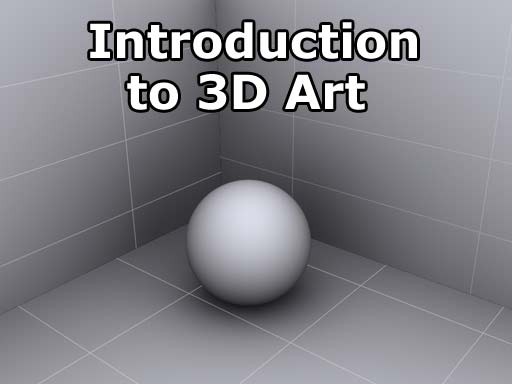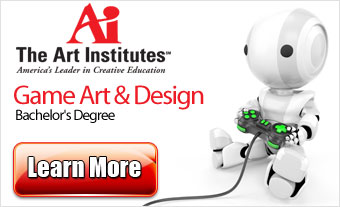
Introduction to 3D Art

So, you wanna be a 3D artist?
Introduction to 3D Art
3D art is created by manipulating polygon meshes and molding them into objects, characters, and scenes. 3D art is used in everything from print ads, to web sites, television, movies, video games, and beyond.
So, what does it take to be a 3D artist? Well, obviously, you must have an eye for art. Most people who begin learning how to do 3D have some kind of background in drawing and sketching. Indeed, it's not unheard of for 3D studios to hire artists who have no experience in 3D art, based solely on the strength of a pencil drawing portfolio. Sculptors, who were previously limited to animatronics and claymation to enter the realm of live-action art, also tend to have an easy time making the transition to 3D.
Even if you don't have formal art training that goes beyond the few classes you took in high school or college for the "easy A," you can still do great work in 3D.
Useful Traits of a 3D Artist
1. Patience. 3D artists need to be patient. Many beginners unfairly compare themselves to established artists possessing years of experience. While it can be a great motivator, and valuable source of inspiration, to examine another's work, don't obsess; 3D art is a diverse subject, and requires a lot of dedication and practice to get acceptable results. Some say that 3D is like Go, the ancient game of strategy: it takes minutes to learn, but a lifetime to master.
2. Sharp. 3D attracts a different breed of artist. 3D artists tend to have a strong background in computers, compared to non-digital artists. Experience in computer programming is common in 3D circles, though certainly not required. 3D artists have an eye for detail, and are extremely resourceful and self-sufficient. Oftentimes, problems you encounter in 3D won't have any analogy in traditional art, and may be no one around to help.
3. Hard work required. If you want something easy, pick up a pencil and paper and start doodling. 3D art is not nearly as immediate in regards to results. One can spend, hours, days, and even weeks perfecting a 3D model before ever moving onto texturing, animation, or final renders. 3D art is unique in that it can require a broad array of skills, from drawing to acting, to successfully bring together a finished piece. The payoff is that, entering the 21st century, 3D artist are perhaps the most sought-after creative workers.
4. Accepting of criticism. Eventually you'll feel motivated to submit your art for review by other artists. 3D artists can nitpick like no one else in the world, so be prepared to have even the slightest errors pointed out to you in exacting detail - especially if you're attempting to recreate anything remotely realistic. If you intend to work in a studio one day, your ability to accept criticism in stride will be crucial to the overall success of the team.
Types of 3D Art
As mentioned earlier, 3D is a broad subject, and a typical finished picture will be composed of several - perhaps dozens - of hours of work in an array of skills. What follows is an overview of the subjects you'll need to learn to be a well-rounded 3D artist.
Modeling - No, you won't be strutting your stuff on the catwalk anytime soon. At least, I hope you won't. Modeling is the act of creating a 3D mesh, whether the end result is a bug-eyed alien or a teacup. How you get to that finished model depends largely on the methods that make the most sense to you.
Animation - Animation is the process of taking a 3D object and getting it to move. Animation comes in a few different flavors. There's keyframe animation, where the animator manipulates the objects on a frame-by-frame basis, similar to old hand-drawn cartoons. Other methods of animation include placing objects on splines and setting them to follow the path of the curve, or importing motion capture data and applying it to a character rig. Yet another way to animate is to use your 3D application's built-in physics engines, such as when your scene requires that objects fall.
Texturing - Texture artists make models look pretty. Without some kind of texture art, everything will be variations of solid colors. The most common and accurate way to create a texture for a model is to "unwrap" the mesh (flatten it out) and paint over it in an application such as Photoshop. The final texture is then "wrapped" over the original mesh again. Depending on how a model is created, each section may have its own texture, i.e., a separate texture for hands, one for arms, and one for the torso of a character, all made to blend together seamlessly.
Rendering - Rendering an image is typically the last step in any workflow pipeline, and is perhaps the most important part. It is a step often overlooked or glossed over by beginners, who are more focused on creating models and animating them. There are many aspects to creating a good final render of a scene, including attention to camera placement, lighting choices which may affect mood and shadows, reflections and transparency, and the handling of special effects, like fluids or gasses.
Everything else - There are many other aspects to creating a good final product. Scenes must be correctly staged, usually working from a pre-visualization rendering, or a quick pencil sketch. Character models must be properly rigged for animation, an art in and of itself. In many big 3D firms, there may be a handful of artists whose sole purpose is to rig up models created by modelers for the animators to work with. Finally, most major software packages allow extensions on the base program in the form of plugins. Programmers may build in features necessary to complete a particular scene or style of animation.
Your First Steps in 3D
The first step in becoming a great 3D artist is to understand the concepts of 3D modeling, and how to create a model that will eventually be useful for animation. Later, you will need to learn the principles of animation, and how to bring your skills together in a fully rendered scene.
3D art is a complex topic that can take months or years to learn. It is also an extremely rewarding venture, and one that is increasingly useful as art is increasingly created on computers. Digital art, and specifically 3D art, is still in its infancy when compared to traditional forms of art. The landscape is constantly changing, and, as a 3D artist, you will have to change with it. Perhaps, one day, your creations will mold the future of 3D art.
Let's get started!
Below are a few schools that offer relevant 3D Art courses.
Digital Media Arts College
The BFA program in Animation focuses on the preparation of the artist to meet the challenges of tomorrow's production workplace. Through a strong foundation in traditional visual and performance arts, students develop their digital content creation skills within a classical framework. During this program students study foundation art skills; including illustration, painting, photography, sculpture and film making, as the prerequisites to an equally diversified animation core curriculum.
Take classes in artist-designed labs and facilities. Learn from experts in digital artistry. Work with industry-standard animation tools, 3D software, and imaging technologies, and one of the only Motion Capture studios in the Southeast U.S. All at Digital Media Arts College
The Art Institute Online-this school offers courses that have been tailored to let the aspiring video game designer have loads of fun while making baby steps towards imaging and animation. With courses like Motion Capture, 3D Animation, Low-Polygon Modeling, Game Level Design and Character Development, among others, you are definitely on your way to completing a portfolio that will not just wow your would-be employers but your future market as well.
The Game Art & Design program concentrates on the artistic side of games - not computer programming. This unique program is your first step toward becoming an artist and designer in the multi-billion dollar game design industry.




